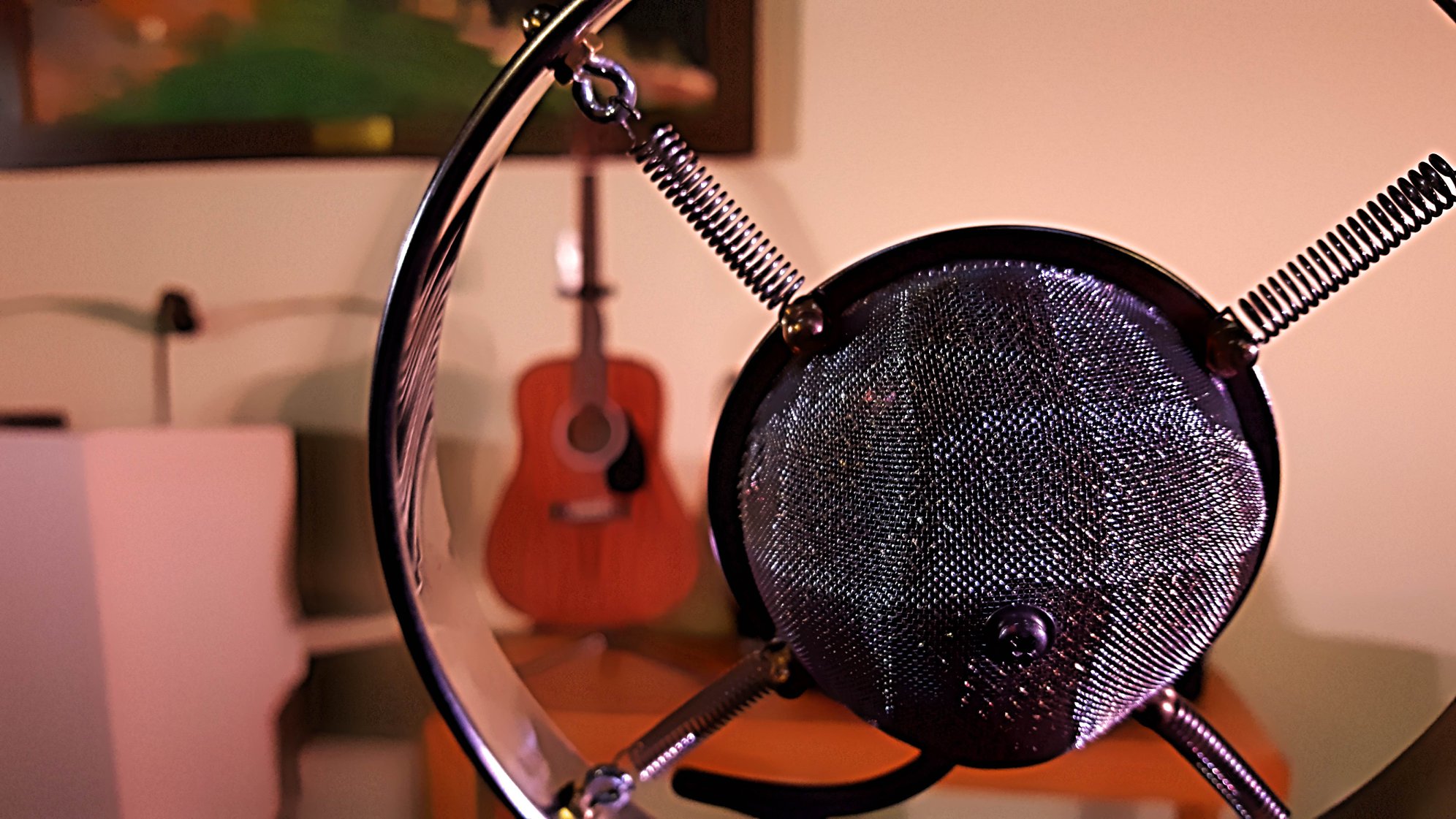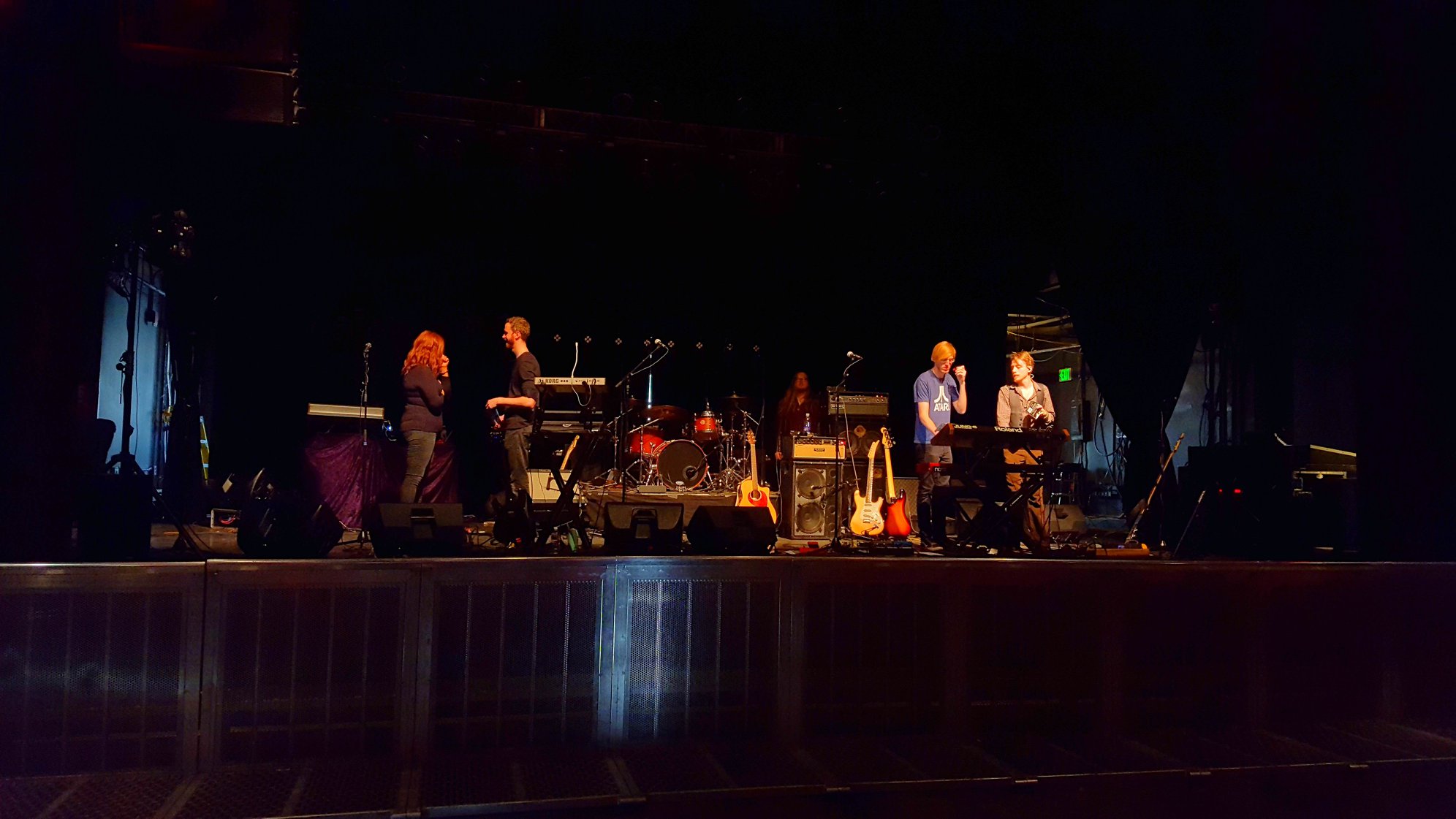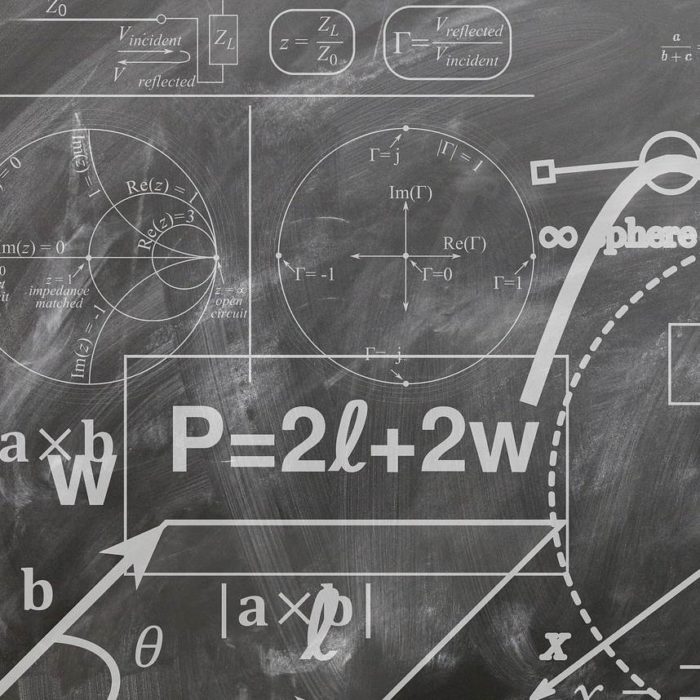It’s very, very different from what you’re probably used to, and also what everybody else is used to.
Please Remember:
The opinions expressed are mine only. These opinions do not necessarily reflect anybody else’s opinions. I do not own, operate, manage, or represent any band, venue, or company that I talk about, unless explicitly noted.

 Want to use this image for something else? Great! Click it for the link to a high-res or resolution-independent version.
Want to use this image for something else? Great! Click it for the link to a high-res or resolution-independent version.I recently had the opportunity to really, really, give the “Good Ol’ College Try” to that technique where musicians gather around a single mic. We did have some spot microphones for extra help and coverage, but the single condenser down-center was definitely the focal point.
The experience was very educational for yours truly. It was one of those times where a whole rush of concepts suddenly transition from the abstract to a concrete understanding. That being the case, here are those concepts (in no particular order):
You have to understand the equipment in play.
That is, you have to understand because other folks might not – and you have to recognize why they might not. There is a conception (which did crop up during the show advance and other prep) that “large diaphragm condenser = omnidirectional mic.” This is, of course, mistaken. Even so, a directional mic like the one we had is handy when players still expect, and possibly are heavily reliant on, the audible support of monitor wedges.
That is somewhat beside the point. The real point is that, of course, an omni mic exhibits consistent tonality vs source-to-capsule distance. A directional unit, on the other hand, delivers far more low-frequency information when a source is close enough for that information’s amplitude to overwhelm the phase differences which produce directionality. You get close, and the bottom end response gets a boost.
The practical upshot for me was that the show’s tonality was heavily dominated by midrange and high-frequency information that I’m not used to hearing without low-frequency content in balance. In other words, it was “thin,” and I didn’t like it all that much. However, a good number of other listeners were quite pleased.
People recognize the concept, but may not be prepared to execute with it.
It’s my estimation, absent any value judgement, that a great many players simply don’t naturally conceive of a band having a polished blend without detailed intervention from production. The idea is lost, then, that everybody else has to drop their intensity to match that of the quietest player. It is simply culturally ingrained that somebody gets turned up to match the average, rather than the average being adjusted downward in some way.
This being the case, it was critical to any semblance of success that those spot mics were available. I had a bit, though only a small amount, of wiggle room to give certain players a push when they needed it.
To actually execute properly on the “one big mic” idea, players have to practice the specific techniques surrounding the strategy. It’s not something that is likely to be achieved on an in-the-moment basis.
Everyone, including you, has to adjust their relationship with audio engineering.
Following on from the previous section, it’s important that I recognize how the conceptions of musicians are often reflected by audio humans, including this one. My mental model of how a band sounds through a PA is that of everything being close-miced and able to be tweaked significantly. This is, of course, similar to what I described above about how a “produced” sound is what’s expected from many musicians.
What we all assume, in other words, is that we (the audio engineer) is there to mix the band; To glue them all together.
With the single mic approach, you really are NOT there to mix the band. You are, instead, on hand to be a steward of the amplification system. It’s your job to find the (possibly fiddly) balance of tonality, gain before feedback, and final, total volume enhancement, and then to be on hand if anything misbehaves. The band is the band, their blend is their blend, and you have very little ability to bend any of that around your desires. Everyone involved, then, has to have a certain level of comfort with that situation. For people used to modern sound reinforcement, this comfort level may not be immediately or easily reached.
TweetWhy We Didn’t Use The EAWs
We already had a solution, why waste it?
Please Remember:
The opinions expressed are mine only. These opinions do not necessarily reflect anybody else’s opinions. I do not own, operate, manage, or represent any band, venue, or company that I talk about, unless explicitly noted.

 Want to use this image for something else? Great! Click it for the link to a high-res or resolution-independent version.
Want to use this image for something else? Great! Click it for the link to a high-res or resolution-independent version.I have plenty to say about a recent foray into a decidedly NOT small venue. Pigs Over The Horizon got booked into The Depot for a night of Pink Floyd madness, and it was astoundingly fun. (That the place was full certainly helped.) I thought I’d start with an absolutely critical piece of the show’s success: Monitor world.
The captain of monitor beach for Pigs is Jason Knoell, not me. As I’ve said before, my job when it comes to Jason is to provide a good starting point. After that, getting out of the way is my major calling.
Now, The Depot is home to a significant collection of EAW JFX260 monitors. We didn’t use any of them. Instead, we brought in our own solution of Yamaha DBR12s and Alto TS312s for most onstage noises, with a “Frankensteined” drumfill of Turbosound subs and JBL Eon tops.
Why? Why forgo some “pro-touring” grade boxes for units you can buy at Guitar Center for a few hundred smackers a piece? Well, it comes down to two things, really:
1. We had a solution already.
I’ll talk more about the specifics of the solution at a later time, but this was the major driver behind my decision. We had a good two days of tech rehearsal before the show, and for me, the best use of that time was to get an onstage solution dialed up. That way, we would be as far along as possible once we got into the real venue; Not starting from scratch, in other words. Jason could recall his monitor mix, and it would be mostly correct. Some tweaks might be necessary due to a transfer into a different acoustical environment. That’s an inescapable thing…but a 100% escapable thing is changing over to different boxes.
Don’t get me wrong, here. I have tons of confidence that an EAW monitor is a well-behaved, easily tuned loudspeaker enclosure. The point is that I knew that what we already had was working exactly as people wanted. I also knew that we wanted to spend the absolute minimum time in the venue “fiddling.” Moving to a different box would likely be a step backward in both respects. We could certainly have a chance at getting lucky and not having any issues, but luck is not how complex shows end up coming off well.
2. The improvement from the EAWs would only have been marginal.
We’re at a point now where internal powering and processing makes affordable loudspeakers pretty darn good. Would the EAWs have gotten louder? Maybe, but likely only by a couple of dB – and we weren’t running anything into its limiters anyway. As such, more level would have been a moot point. Would a JFX260 have sounded better? Again…maybe? Or maybe not, depending on the preferences of the musicians. The Altos and Yammies are tuned well enough out of the box that running them flat and getting good results isn’t a struggle. I don’t think Jason had to fight their transfer functions at any point. It’s not like we were having trouble with unruly monitors, where an EAW would have made an ocean of difference. The potential upgrade would have been minor, and mostly aesthetic, and nobody was complaining anyway.
When you add it all up, moving to the in-house monitor wedges would have been mostly an “on-paper” upgrade of questionable effectiveness. JFX260 enclosures are certainly classier than what we brought in, but going with what we knew and had dialed up to our precise specifications was (in my mind) the smart play.
The Progressive Load In
It’s not always possible, but it can be great when you’re working solo.
Please Remember:
The opinions expressed are mine only. These opinions do not necessarily reflect anybody else’s opinions. I do not own, operate, manage, or represent any band, venue, or company that I talk about, unless explicitly noted.

 Want to use this image for something else? Great! Click it for the link to a high-res or resolution-independent version.
Want to use this image for something else? Great! Click it for the link to a high-res or resolution-independent version.I get lots of help on gigs, and I prefer working with a team, but there are times when I fly solo. In those situations, I’ve discovered a method of working that’s a little unconventional – but also very likable. I call it “progressive load-in” or “sequential load-in.”
The idea is very simple. Instead of getting everything into the room and then starting the setup, I make a trip from the van to the venue, and setup as much as I can with what’s in the room in that moment. The process then repeats until everything is in – and set.
There are two benefits to working this way.
1) It’s far less tiring. With the way my van has to be packed, constantly jumping in and out of it to muscle gear around can really sap a person’s energy. Breaking that activity up with less strenuous tasks is a big help.
2) I make setup progress much earlier. With the “get it all in” method, there’s a big block of time that’s just situating the non-deployed equipment in the room. Plus, I almost always manage to block my access to something or otherwise end up rearranging cases and tubs. Doing things in parts means that, even though the total time required is similar, I get a bit of an edge – and at any given second, I tend to have more done for that fateful moment when musicians are coming in the room and looking to soundcheck.
There are certainly times when this method simply doesn’t work. If you have to move your vehicle from a loading zone ASAP, a progressive load in isn’t going to fly. When I have helpers for loading, it’s also generally a better idea to do things in blocks.
When a progressive/ sequential load-in IS possible, though? It’s kinda neat.
Mercenary Maxims: Part 5
There are times when the bizarre, convention-breaking approach is what you need to survive.
Please Remember:
The opinions expressed are mine only. These opinions do not necessarily reflect anybody else’s opinions. I do not own, operate, manage, or represent any band, venue, or company that I talk about, unless explicitly noted.

 Want to use this image for something else? Great! Click it for the link to a high-res or resolution-independent version.
Want to use this image for something else? Great! Click it for the link to a high-res or resolution-independent version.Sometimes the only way out is through… through the hull.
You and I both have probably done it: Looked at the control settings on a console, loudspeaker manager, or really any piece of audio gear and thought: “What in blazes was this person thinking?” It’s not entirely without justification. There’s a general range of ideas in audio that make sense, and getting outside that range can indicate that someone doesn’t know what they’re doing.
It especially indicates that someone doesn’t know what they’re doing when a very odd configuration is dialed up without any listening being done. If you add to that an inability of the operator to explain why they did something (beyond “I always do it this way,” or “So and so did this”), then you have a good indication that the heterodox approach in play might not be advisable.
But what if they CAN explain why they’ve done something weird? What if they have listened, listened indeed, and come to the conclusion that the way to best get through the show is to really, REALLY twist the knobs? In such a case, the total acoustical result – what you can hear, in other words – is the deciding factor about something being “right.”
Orthodox methodologies are a proper starting point. Going into the solving of an audio problem with a rational baseline helps with not solving the original problem AND a new one before you’ve made any real progress. What you have to watch out for, though, is the belief that “this should sound right because the knobs are pointing in a reasonable direction.” That’s not always true. I’ve said before that I’ve been in stage-wash situations where high-pass filters were set in the kHz range. The settings looked wrong, but sounded much cleaner than the alternative. I’ve had reverbs fed from pre-fader sends when they were wanted in monitor wedges. Post-fade is the normal way to go, yes, but you have to take a different route if your options are limited and you don’t want the verb in the wedges to change as your FOH mix changes.
Sometimes you have to cut your way out. The important thing is to get the experience necessary to know when doing something drastic is truly required, and also to know when it’s neither required nor justified.
The Transcendent Experience
It’s the alignment of many variables, and is rarely produced on demand without a lot of time and effort.
Please Remember:
The opinions expressed are mine only. These opinions do not necessarily reflect anybody else’s opinions. I do not own, operate, manage, or represent any band, venue, or company that I talk about, unless explicitly noted.

 Want to use this image for something else? Great! Click it for the link to a high-res or resolution-independent version.
Want to use this image for something else? Great! Click it for the link to a high-res or resolution-independent version.One of the best, live-music vocal tones I have ever heard was produced by Katie Ainge. It was in a concrete and glass coffee shop, one of the most acoustically hostile places you can imagine. The mic was probably not anyone’s first choice; I think it was an SM48, or something similar. The PA system was nothing even close to a Vertech, VDOSC, EAW Anya, or…well, you get the picture. I think it was a Roland keyboard amplifier. There was no mixing console.
But the sound of Katie’s voice was still perfect. The basic timbre was rich and beautifully balanced alongside the intelligibility zone, with a studio-quality top end you’d swear was coming from a world-class condenser.
How was the result so perfect? It was simply because the entire setup completely fit in with Katie’s strengths and singular performance style in that room. It wouldn’t have worked quite so well for anyone else – although I’m sure it would have been reasonably okay, because the basic dial-in was probably solid.
All this is to say that “The Transcendent Experience” of sonic bliss is often driven by a whole bunch of factors lining up for a specific and very exact set of circumstances. It’s why an engineer who insists on getting “their sound” all the time will struggle with some bands (maybe even many or most acts), but then also meet the groups for whom nobody else will get results as good. The engineer’s aesthetic lines up with the band’s aesthetic like tumblers in a lock, and it’s magic when the key turns.
“The Transcendent Experience” is something that I have mixed feelings about. I enjoy it when it happens, and I think that there’s a certain worthwhile element to it. If an artist has the time and money required to go after every single factor that creates exactly the right sonic conditions for their shows, I say, go for it! At the same time, my own situation demands a certain kind of pragmatism: I need to fit my own workflow, but it’s not practical or advisable for me to cater to a niche sound. I might be running an acoustic-music show for one engagement, and then be doing rock the next. Consequently, my approach and my gear need to be generalized rather than specific. I can’t focus on making one act, or even one kind of act sound “beyond perfect.” Rather, I have to have a “works reasonably well everywhere” sort of mentality at most times. (I do enjoy working with and developing the sonic presentation of specific bands, though.)
My encouragement, then, to myself and others, is to embrace what you’re made for. You might be the person who’s going to work with the next Metallica, spending a career laboring over the perfection of the ultimate, heavy show. You might be more like me, working in a variety of situations that demand solid basics and adaptability. The key is to recognize what you’re trying to do, and not see “The Transcendent Experience” as the only measure of success. It’s important, yes, and great when it happens, yet we also have to deal with how elusive it is. Perfect is often the enemy of good, and being reliably good is the first and most achievable goal for any audio craftsperson.
Getting Total Control Of Loud Is Even More Loud
Pushing 10 dB ahead of stage garble can be punishing for the crowd.
Please Remember:
The opinions expressed are mine only. These opinions do not necessarily reflect anybody else’s opinions. I do not own, operate, manage, or represent any band, venue, or company that I talk about, unless explicitly noted.

 Want to use this image for something else? Great! Click it for the link to a high-res or resolution-independent version.
Want to use this image for something else? Great! Click it for the link to a high-res or resolution-independent version.I believe it was Mark Hellinger who once said that audio engineers don’t feel like they’ve got real control over a show until the PA is 10 dB louder than everything else. I’m pretty sure he was right, both due to my own experience and a bit of SPL math.
When adding SPL levels, you use the formula: 10 * log10(10^SPLa/10 + 10^SPLb/10 + …) to get your answer. So, if the sound from the stage is 100 dB SPL, and the PA is also making 100 dB SPL, you get 10 * log10(10^10 + 10^10), or 103 dB SPL. The implication there – beyond things simply getting louder – is that the sonic contribution from the stage is quite large in proportion to the FOH PA system. Wind up FOH to 110 dB SPL, and something curious happens. You end up with 10 * log10(10^10 + 10^11), or 110.4 dB. See that? The 110 dB from FOH essentially overwhelms the wash from the deck.
Great, right?
But think about how loud that is. Then, think about how loud it is if the band is REALLY cookin’, and monitor world is on the gas. You might have a band making 105 dB SPL or more. Thus, if you want to “get control” with FOH, you have to get things barking at 7 – 10 dB above that level. One hundred and fifteen decibels across the board (not just subwoofer material) is not much fun to most folks.
You have to watch out for your tendency to try for an FOH takeover all the time. It will often be your first instinct. It’s often mine. Even though I’ve managed to put it somewhat into check, I still have a strong bent towards guessing too high. I especially guess too high when there’s a lot of musically uncorrelated noise, like audience chatter. That’s not what I want to listen to, and I unconsciously build my mix around drowning out the conversation. Sometimes, folks are okay with that. At other times…not so much.
Be mindful of the numbers. Try to be careful. Have the idea that not being in total control of the sonic experience is okay, because the cost of total control may be marked discomfort for everyone around you.
Mercenary Maxims: Part 4
I will endure a lot – if the crew is great to work with.
Please Remember:
The opinions expressed are mine only. These opinions do not necessarily reflect anybody else’s opinions. I do not own, operate, manage, or represent any band, venue, or company that I talk about, unless explicitly noted.

 Want to use this image for something else? Great! Click it for the link to a high-res or resolution-independent version. Original image found on Pixabay: https://pixabay.com/en/ice-cream-cone-melting-hot-1274894/
Want to use this image for something else? Great! Click it for the link to a high-res or resolution-independent version. Original image found on Pixabay: https://pixabay.com/en/ice-cream-cone-melting-hot-1274894/If the Food is Good Enough, the Grunts Will Stop Complaining About the Incoming Fire.
I don’t think I can over-stress how important the “people factors” are in this business. Technical prowess, the right gear, logistics coordination…all those things are important, but they don’t stay glued together without excellent people.
Or, to present it the other way, nothing has ever made me dread a show more than the anticipation of working with unpleasant personnel. I can laugh-off most technical misadventures. I’m at peace with what audio humans can and can’t fix, from musical arrangements to acoustics. Terrible load-ins? Those can be handled. But put people who are hard to work with into the mix, and even a great show at a great venue isn’t so hot anymore. I’d rather be somewhere else.
The success threshold isn’t that high. What’s required is nothing more than general politeness, a strong sense of how the show is a “team sport,” and the ability to find the humor in all the foibles and fumbles associated with a gig. Being a guru at all things audio and lighting isn’t the make or break element, helpful though it is. Whether you can master the kindergarten-level imperatives of getting along with others is the fundamental element.
I’m spoiled, by the way. I regularly get to share workspace with some of the most professional craftspersons I can imagine. Folks who are highly proficient in technical execution while being patient, funny, kind, and helpful. We can load-out at 3:00 or 4:00 in the morning with a smile and a laugh, because we’re a team. We’re there to help each other win as a group, rather than to feed our own individual egos. We can chuckle at ourselves.
In contrast, I’ve been in more than one situation where the importance of the above has been demonstrated in the negative. I am especially put-off by folks who turn around and bark at me because I didn’t telepathically ascertain what they wanted next. (This goes over even more poorly when I’m essentially bailing them out of a tight spot.) When such a thing happens, I think a couple of thoughts to myself:
1) “Dude, the color of your chakra alignment pathways is a sort of oxidized, black Camaro, and what we need now is more of a Caribbean azure.”
2) “I hope this person never calls me again.”
There’s almost no show out there, of any difficulty, that can’t be made at least tolerable by involving great people.
…and there’s no “plush,” easy gig that can’t be made intolerable by bad attitudes and an inability to be polite.
Mercenary Maxims: Part 3
A LOT can go wrong – and you can still survive – if you have backups.
Please Remember:
The opinions expressed are mine only. These opinions do not necessarily reflect anybody else’s opinions. I do not own, operate, manage, or represent any band, venue, or company that I talk about, unless explicitly noted.

 Want to use this image for something else? Great! Click it for the link to a high-res or resolution-independent version. Original photo is a CC0 found at Pixabay: https://pixabay.com/en/aircraft-military-thunderbolt-a-10-1008284/
Want to use this image for something else? Great! Click it for the link to a high-res or resolution-independent version. Original photo is a CC0 found at Pixabay: https://pixabay.com/en/aircraft-military-thunderbolt-a-10-1008284/Close Air Support Covereth A Multitude Of Sins
Do you know why some folks stay very, very calm when a show is beset by multiple failures?
There are many possible reasons, some of them involving good internal psychology: An ability to put things into perspective and not panic is very important. At the same time, real fallback options, both physical and those based in planning, are critical when your bacon requires saving. I’ll even go so far as to say that the planning part takes the crown. Not everyone can have a whole pile of spare mics, extra cables, or even a whole console left over in case of an emergency – but everyone can take the time to think through what might go wrong.
Some production crafts-humans only ever think about what it takes for a show to happen the right way, and don’t bother to ponder the failure points. Those folks have a much steeper hill to climb when it comes to maintaining control in a tough situation, because they have no mental preparation. In contrast, the audio and lighting people who have stopped to ponder “what do we do if [insert piece of gear] fails?” have a big lead. They’ve already been to the failure point in their head. They’ve seen the mountain! So, if a problem occurs, they’re not in completely unfamiliar territory.
Thus, ask yourself: What are the critical pieces for the show? Where can you yank bits and pieces from in case one of the critical pieces fails? What if you lose half your inputs – how do you keep going? If FOH dies and there’s no spare, how would you go about creating an FOH mix from monitor world? How about the other way around? How do you rearrange things if you lose a wedge 10 minutes in? How would you repurpose a subwoofer amp to drive a pair of monitors if another amp died? If one of your lights quits all of a sudden, what other light can you quickly take “offline” to keep things symmetrical? What in your rig is the most likely thing to misbehave at a critical point?
Having thought some things through, have an internal checklist that you can run through. You want a procedure, even if only roughly outlined, that you can go through without thinking too much. This protects against panic and keeps your fixes moving at the highest speed possible.
…and know your gear! Know what extra inputs and outputs you have. Think about what you could adapt to feed something else, even if it’s not the standard method. There all kinds of unorthodox ways to survive disasters of various magnitudes, and if you’re familiar with what your equipment can do you can dream up some pretty interesting solutions.
I encourage you to have all the backups you can afford, and are able to bring with you. That includes the backups that are “merely” contingency plans sitting in your head. One the day when you encounter a failure, you will have a much better chance at being the calm and cool one in the bunch.
Mercenary Maxims: Part 2
You might have seniority on the crew, but you might not be right about everything.
Please Remember:
The opinions expressed are mine only. These opinions do not necessarily reflect anybody else’s opinions. I do not own, operate, manage, or represent any band, venue, or company that I talk about, unless explicitly noted.

 Want to use this image for something else? Great! Click it for the link to a high-res or resolution-independent version. Original photo is a CC0 found at Pixabay: https://pixabay.com/en/fairground-lights-amusement-park-1149626/
Want to use this image for something else? Great! Click it for the link to a high-res or resolution-independent version. Original photo is a CC0 found at Pixabay: https://pixabay.com/en/fairground-lights-amusement-park-1149626/A Sergeant In Motion Outranks A Lieutenant Who Doesn’t Know What’s Going On
It’s not uncommon that I’m a part of a show crew where a person who’s technically “junior” to me ends up being the smartest person in the room. They’ll notice something I don’t, or come to a problem with a fresh set of assumptions, and advise me on a better course of action.
When I’m being smart, I listen.
Essentially arbitrary measures of authority, that is, decision-making power, aren’t always helpful in the churning, kinetic fluid that we call concert production. They do have their place, of course. I definitely find it best when there’s a singular vision for overall planning, and when you have a person where the buck very certainly stops. A crew on a gig ought to have someone available who can and will say, “This is what we’re doing” when it becomes necessary to say that.
…but to assume that the higher-ranking human is always right, no matter what, in all times and circumstances, is shortsighted. If another production professional who’s farther down the authority-tree can’t say that the right way to execute might be something different, you have a problem. Further, when things are going badly, the crew member who’s clued into the snafu and taking action is the guy or girl to be listening to. An oblivious person higher up the chain can’t do much for you, and a show in progress is all about NOW. When monitor-world is melting down or FOH just stopped behaving, the crewmember ready to act and rectify the situation doesn’t need to get permission.
When a short-timer talks, you should perk up your ears. If they’re wrong, you can explain what they’ve missed, and if they’re right, you can benefit from their insight. Also, don’t forget that “short-timer compared to you” doesn’t necessarily mean that you automatically know more or have greater wisdom about any particular thing. The person teaching you all about that new console might be a decade behind you – and they might know everything there is to know about how to operate that monstrosity, because that’s where they’ve spent their time. Pay attention.
Mercenary Maxims: Part 1
The order you do things in matters.
Please Remember:
The opinions expressed are mine only. These opinions do not necessarily reflect anybody else’s opinions. I do not own, operate, manage, or represent any band, venue, or company that I talk about, unless explicitly noted.

 Want to use this image for something else? Great! Click it for the link to a high-res or resolution-independent version. Original photo is a CC0 found at Pixabay: https://pixabay.com/en/geometry-mathematics-cube-1922743/
Want to use this image for something else? Great! Click it for the link to a high-res or resolution-independent version. Original photo is a CC0 found at Pixabay: https://pixabay.com/en/geometry-mathematics-cube-1922743/I’m a longtime fan of Schlock Mercenary, a comic about a spaceborne military unit for hire. One of the features of the story is The Seventy Maxims of Maximally Effective Mercenaries, a collection of proverbs regarding mercenary life.
A funny thing that I noticed was how you can apply those proverbs to the live music world as well.
Thus, I am today embarking on a series that looks at how some of the Maxims relate to being an effective audio human. I’m not sure exactly how long the series will run, or if it will be “on again, off again.” We’ll all have to find that out together. It’s an adventure! You like adventures, right?
Pillage, Then Burn
When working on shows, I’ve noticed that taking actions out of an established order can cause problems:
“Hey…why isn’t [this or that] working? Where’d [this or that] go?”
It’s all because workflow has a real impact on getting things done quickly and effectively. When you’re running on a tight workflow, one that’s well-defined, “ticking all the boxes” is much easier because you don’t have to stop to think about which boxes have full or partial checkmarks in them. You don’t complicate the work by having to keep in mind the organization of the work. Things are much less likely to be forgotten.
Now, the point here is not that any particular kind of work organization is the right one. For instance, I like to wrangle tasks in blocks when I can – get all the power sources and drops figured out, then place everything, then plug everything into a power supply, then run signal, etc. You might prefer a one unit at a time approach. Either way works. The key is trying not to have something interrupted midstream, like getting halfway done with plugging power and then running off to manage a signal run to FOH. An hour later, you’re wondering why half your powered wedges don’t work – and then you realize that they never got electricity connected.
The above is a “macro scale” application. Another way in which order of operations matters is accessibility for connection and configuration, which is a “micro scale” consideration. Through long experience, I’ve learned that sometimes you DON’T want to lift or hoist everything to its final trim height at the same time. Running signal between loudspeakers or light trees? Connect the power and input signal, and ALSO connect the output signal drop. Don’t complete the output run – just get a pigtail ready that will be easily accessible once its source connection is in the sky. Check all your switches, and flip the power on if that would be hard to do later. Then, lift whatever you’ve just been fiddling with to its working height. Do any final cable dressing for that piece of the system.
What you end up with is a piece of your setup that’s in the air, with everything pertaining to it connected so that you don’t have to try to work on it while it’s out of reach. With an output drop connected and dressed, you also know whether you’ll need to extend the drop (or not) to have enough allowance of slack for lifting the next piece.
Getting this wrong means dropping hangs/ lifts back in to work on things, or trying to find a ladder, chair, or stepstool at an inconvenient moment. (Ask me how I know this…)
Doing the work in the right order is important at all scales. It helps ensure success by way of The Law Of Conservation Of Effort: You get to put almost all your effort into doing the work, and very little has to be expended on ad-hoc project management.